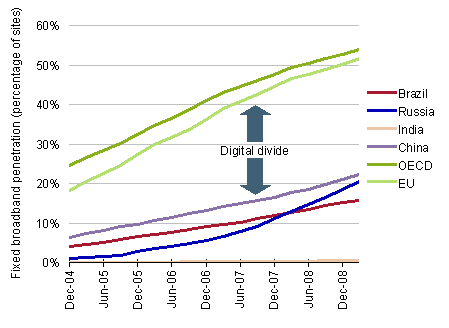| Рубрикатор |  |
 |
| Все новости |  |
World News |  |
 |
How can developing markets bridge the broadband digital divide?
| 28 августа 2009 |
The penetration rate for fixed broadband services in developing countries continues to lag that in their more-developed counterparts, despite the wealth of socioeconomic benefits that broadband access can bring.
Mobile services offer these countries an alternative evolutionary path, but a well-designed policy that considers all technologies is the best method of ensuring that broadband’s greatest benefits are made as widely available as possible. Policymakers need to do more to encourage operators to invest in broadband if developing countries are to reap the rewards.
The digital divide between developing and developed countries continues to widen
Broadband, and more generally ICT, has revolutionised social and economic interactions in the developed world. It was no surprise that, as the economic downturn was felt in the developed world, many governments allocated funds in their economic stimulus packages specifically for investment in broadband. These actions reflect the generally accepted belief that broadband enables socioeconomic change for the better.
In developed markets, the term ‘digital divide’ is often used to describe the difference in connectivity between rural and urban areas, but it can also be applied more broadly to the divide between broadband evolution in developed and developing countries. This divide continues to be significant: the level of fixed broadband site penetration in the ‘BRIC’ countries (that is, Brazil, Russia, India and China) is less than half of that in more-developed countries, such as the members of the OECD and the EU (see Figure 1).

Figure 1: The digital divide in fixed broadband penetration between BRIC, OECD and EU countries, December 2004–March 2009 [Source: Analysys Mason, 2009]
But fixed broadband is no longer the full picture, and the roadmap for ICT evolution in developing markets beyond 2009 is quite different from that in developed markets earlier in the decade. Mobile devices have a higher penetration rate than PCs in most developing markets and, following the launch of mobile data and broadband services, can substitute for wireline access infrastructure and for computers. Mobility is not the most significant aspect of mobile data services in these countries, where such services are typically used at a fixed location. Instead, because wireless infrastructure can provide greater coverage than its fixed equivalent, and low-end data-capable mobile handsets are cheaper than PCs, mobile data services reduce the two main barriers to entry: being in an area of connectivity and cost.
Broadband can bring significant benefits despite its cost
One significant advantage that fixed broadband has over use of mobile handsets for data access is that many users can access information simultaneously, which can lead to sizable gains in productivity. Furthermore, the labour-intensive infrastructure roll-out required to increase the availability of fixed broadband creates jobs and subsequently increases productivity through more-efficient communication. Broadband can also bring foreign investment to emerging economies in the form of business process outsourcing, and there are wider-ranging benefits to the education and healthcare sectors as well as to government communications.
For smaller businesses in developing markets, newspapers and radios currently constitute the primary means of disseminating information – for example, on prices of livestock and crops, new agricultural methods and weather forecasts. Broadband’s ability to deliver a rich array of timely information on demand gives it an advantage over these more-traditional information sources and over other telecoms options, such as low-speed mobile data services, and could provide short-term benefits as well as improve the long-term viability of a business. Unfortunately, the prohibitive cost of computers and connectivity means that it will be beyond the means of many small businesses to take advantage of the benefits of broadband in the near future, unless costs can be reduced and availability improved.
Appropriate broadband policy can create an environment that fosters growth
In the recent report, Creating successful broadband policies in developing countries, Analysys Mason identified and discussed the measures that are required to bring about a supportive environment that fosters growth and investment in the broadband market in developing countries. From costless changes in policy to direct industry subsidies, the primary measures needed to achieve these ends include:
-
reducing risk with a strong regulatory environment
-
stimulating investment through demand aggregation and subsidy auctions
-
creating a competitive market for backbone and submarine cable capacity
-
getting spectrum auctions right
-
increasing the value of broadband services to end users.
Implementing each of these measures one at a time will not maximise their impact. Indeed, some of the issues that these initiatives aim to address cannot be solved in isolation. Implementing a full range of complementary demand- and supply-side policies accrues the greatest benefit. Through such an implementation, policymakers can create an environment that will maximise growth in broadband penetration and will, hopefully, begin to close the digital divide. Broadband will then begin to reach new audiences, bringing with it a variety of socioeconomic benefits.
Martin Scott, Senior Analyst
















Оставить свой комментарий:
Комментарии по материалу
Данный материал еще не комментировался.